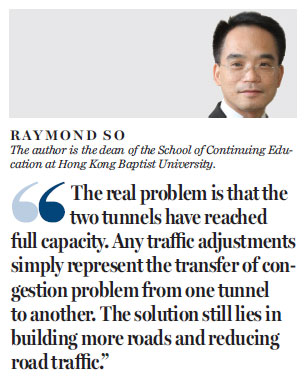How to smooth traffic flows in Hong Kong's cross-harbor tunnels
Updated: 2016-08-11 08:11
By Raymond So(China Daily)
|
|||||||||
When the government recently took over the Eastern Harbour Crossing (EHC), which marked the end of its 30-year franchise, there were people asking the government to make toll adjustments to resolve the problem of traffic congestion in and around the three existing cross-harbor tunnels.
The most popular suggestion is for the Cross-Harbour Tunnel (CHT) to increase its toll and the EHC to reduce its toll. The government has indicated that it will examine the tolls of the three tunnels and a report, which is due in 2017, will be submitted to the Legislative Council for discussion. So, there is no immediate solution. Nevertheless, it is still a pragmatic approach given today's political climate.
The EHC is a "build-operate-transfer" (BOT) project. The project winner was awarded it in the 1980s. At that time, there were uncertainties about the handover of Hong Kong and inflation in the early 1980s was also high. Given these factors, the "reasonable and not excessive" allowable return for the EHC was determined to be 16.5 percent. It was a high return figure by today's standards, but considered "reasonable and not excessive" then. In 2010, the EHC operator applied for toll hikes in order to maximize its return in spite of strong sentiments against such increases. When the application was rejected by the Chief Executive in Council, the EHC operator resorted to arbitration and lost the case.
In addition to the return requirement, there was also a policy goal behind the construction of the EHC, namely, to connect the eastern part of Hong Kong Island with Kowloon, so factories in eastern Hong Kong Island can have a direct transportation link to the New Territories and the mainland. Of course, it has been proved later that the traffic flow between the eastern part of Hong Kong Island and Kowloon was far below that of the original plan. The lower traffic flow, plus the high return requirement mentioned above, forced the EHC to charge a higher toll.
On the other hand, the CHT is owned by the government, which does not charge a high toll. Together with its geographical advantage, the CHT is the drivers' preferred option over the EHC. Nowadays the traffic flow of CHT has already reached 150 percent of the original limit, and the EHC is almost at the point of 100 percent of its capacity. In short, the congestion problems at the two tunnels are considerable. This comes to an interesting issue: Even though the government is willing to alter the tunnel tolls, there is little hope of solving the problem of traffic congestion. The key is that no matter how the traffic flow is transferred from one tunnel to another, the capacities of the two tunnels have simply reached their limit.
The last administration actually studied this issue and a consultancy report was produced. At that time when traffic at the EHC was not saturated, there were plans to increase the toll of the CHT and reduce that of EHC. But people resented the idea of increasing the toll of the CHT. In theory, different toll prices can help to divert traffic flows. However, the price difference must be large enough so drivers have the incentive to change. In the old days when the EHC charged lower than the CHT, the EHC still could not attract significant traffic flow from the CHT. This shows that a small price difference will not have a material impact on the behaviors of drivers as past experience had already demonstrated this. The government is now suggesting that further study should be done so a more updated picture of the traffic problem can be examined. This may sound slow to many people. However, given the current political environment and the recent developments since the last consultancy report, the government's approach is pragmatic and practical.
The real problem is that the two tunnels have reached full capacity. Any traffic adjustments simply represent the transfer of congestion problem from one tunnel to another. The solution still lies in building more roads and reducing road traffic. This is easier said than done. Without sufficient land to build more roads, adjusting tunnel tolls alone will not solve the problem.

(China Daily 08/11/2016 page12)